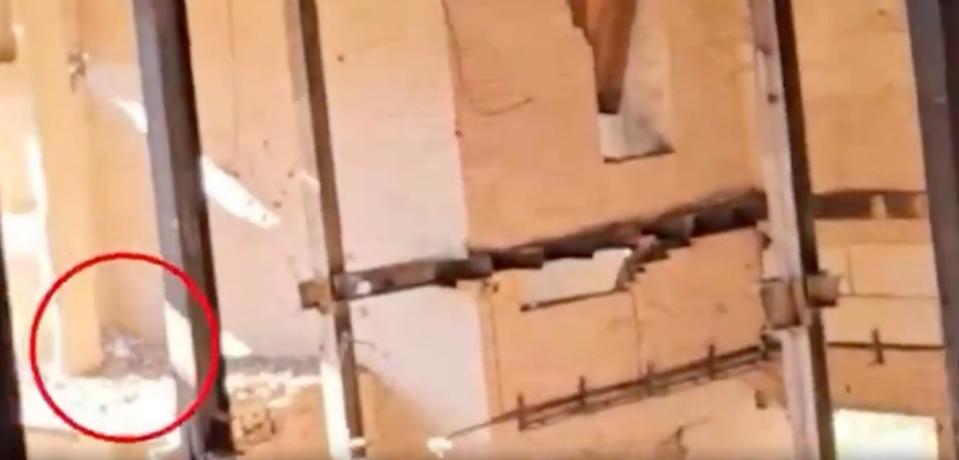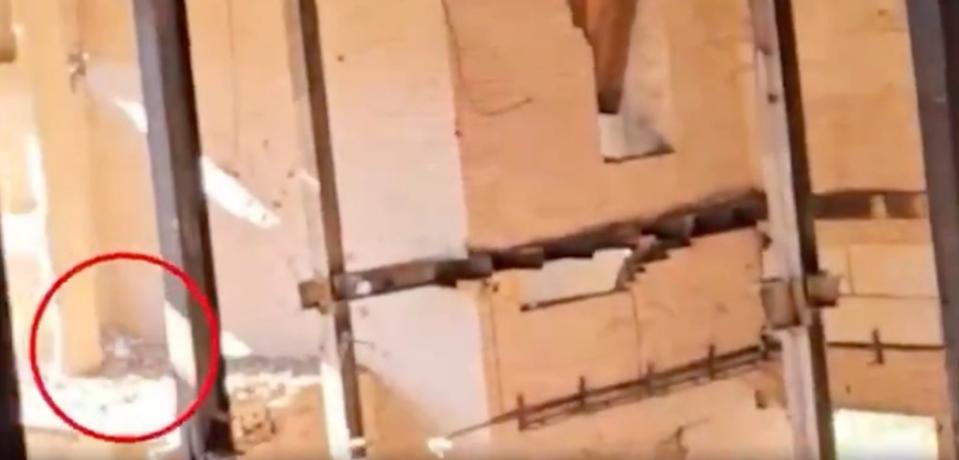Standing against a brick wall in the shattered shell of a building somewhere in the Ukraine war’s combat zone, the Russian military correspondent peered out from his hiding spot in a small room as the terrifying buzz of an approaching drone filled the confined space.
“Bitch,” he whispered as the whining noise drew closer.
The chilling video posted on social media shows how drones can hunt down troops even when they are seeking cover inside a building. It highlights how – when optimized for urban environments and capable of maneuvering in tight spaces – weaponized drones are becoming an increasing fixture of urban warfare.
The video has the tension of a slasher movie scene. After about 45 seconds, the small drone is seen entering the building and flying close to the floor. It navigated around some thin metal beams and what appeared to be a cinderblock-enclosed stack.
“Turn on the EW, it’s in the factory,” he called out.

Seconds later, there was a loud explosion and the camera shook.
“It went off,” the correspondent said, before letting out a relieved sigh that he survived the encounter.
Twitter is full of videos showing troops being hunted down by first-person view (FPV) drones and usually out in the open. This one offered a rare glimpse into what it is like to be hiding inside a structure while attempting to avoid being struck.
As we have noted before, drones are being developed to find and destroy enemies inside buildings.
Last year, we wrote about a video that emerged on social media of a drone being used by Israeli security services to scout a building in a densely populated West Bank city. It was observed on a security camera hovering outside the building, before flying inside. A loud explosion followed. You can see that video below.
I’ve heard reports about the IDF using small drones but I believe this might be the first documentation of a drone used by Israeli security forces to scout a position in the West Bank (likely Nablus) and then appears to detonate when it enters a building. pic.twitter.com/sJfA0h6199
— Joe Truzman (@JoeTruzman) February 14, 2023
There was no identification of the drone’s type, but it bore a striking resemblance to Elbit Systems of Israel’s LANIUS search-and-attack drone that was recently introduced at the time, or a small system generally like it. LANIUS is a small 2.75-pound quadcopter that is based on racing drones, giving it the capability to agilely fly into hard-to-access urban areas for intelligence gathering and even kill missions. You can learn more about the LANIUS in great detail here.

Weaponized FPV drone capability, in particular, has developed in the war in Ukraine, and the danger posed by it is driven home on a daily basis there. These drone capabilities are now showing up in other hotspots around the globe as the technology and techniques used to build and employ them proliferate. Cartels in Mexico are especially fond of explosive FPV drones, for instance.
WILD
A drone attack targeted Ecuador’s La Roca prison, where former Vice President Jorge Glas is being held. Glas was arrested in a controversial police operation at the Mexican embassy this past April.
Via @Mrgunsngearpic.twitter.com/86FgsOOaB4
— Open Source Intel (@Osint613) September 9, 2024
The inevitability of this development is something we examined eight years ago, as the U.S. Marine Corps was beginning to look at integrating small drones at the squad level.
“There is also the reality that these micro- and nano-drones will eventually morph into optionally suicidal loitering munitions, something we discussed in depth recently. That same drone operator position in the Marine rifle squad could one day (probably not far off) choose a Black Hornet with orange bands on it, loaded with a small explosive charge, and fly it right into the window where an expected sniper is hiding. BANG! No more sniper. This is already being done in the lower end of the winged unmanned aircraft market, with the AeroVironment Switchblade and IAI’s Harop suicidal drone leading the way.”
The fact that the explosion seen and heard in the video did not appear to cause any injuries shows the complexity of flying into a tight space and trying to maneuver around obstacles.
Most FPV drones are equipped with man-in-the-loop control with a continuous line-of-sight datalink between the drone and its operator who manually steers it is required. Having man-in-the loop control makes these types of drones highly maneuverable, with operators able to rapidly switch targets.
However, there are limitations.
They can be impeded by a range of factors including distance, terrain, structures, and, as the video showcased, by the internal layout of a building, as well.
One workaround has been using drones, aircraft, or balloons to relay signals to FPV drones, extending their somewhat limited line-of-sight range. In an urban environment, using a cellular connection can also get around these issues even when operating relatively deeply within buildings.
As part of the battlefield innovations, both sides are now using drones guided via fiber optic cables. The advantages are that they are immune to electronic warfare countermeasures and do not emit signatures, which are often used to track down where they are launched. Another advantage is that their connections do not breakup while flying very low to the ground or even inside buildings, offering a clear feed to the controller where line-of-sight radio link would degrade or fail. You can see exactly such an scenario in the video below showing one of these drones hunting soldiers inside a building.
Russian fiber-optic FPV drone hits a group of Ukrainian soldiers inside a building.
Fiber-optic FPV drones are notable for their ability to provide high-quality video transmission and reliable control.
They also maintain a continuous and stable video signal. pic.twitter.com/SYNe9gA6PN
— Clash Report (@clashreport) September 6, 2024
There are downsides to this as well though. The cables can be snagged and trailing it can reduce one of an FPV drone’s greatest advantages, its maneuverability. Range can also be severely curtailed.
To overcome some of the challenges, Ukraine has created a school for FPV drone operators, teaching them how to fly over, around and through obstacles.
“We have a constant need to train our pilots and operators,” one of the instructors, code-named Teenager, said in a video about the school. “The world of unmanned systems is constantly changing and the enemy comes up with certain methods or can prevent us from completing our tasks. We have the opportunity to constantly train and improve our skills.”
You can see that training in the following video.
The Russian correspondent being hunted by the drone was lucky enough to live through the incident. As drones continue to develop, especially when controlled by artificial intelligence, such good fortune will become increasingly harder if not nearly impossible to come by.
Contact the author: howard@thewarzone.com
EMEA Tribune is not involved in this news article, it is taken from our partners and or from the News Agencies. Copyright and Credit go to the News Agencies, email news@emeatribune.com Follow our WhatsApp verified Channel





